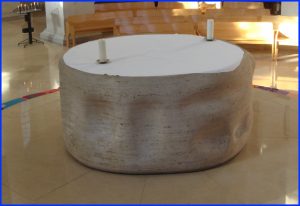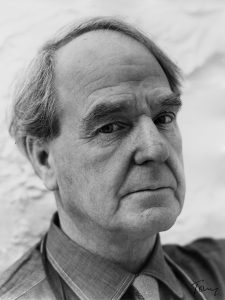| At the heart of the redevelopment at St Stephen Walbrook there is a major statement about the theology of the Church in the city. That is the large altar by Henry Moore commissioned by Lord Palumbo for the church during it’s restoration in 1978. It was carved in 1972. |

St Stephen Walbrook was the only church designed by Wren in 1672 and was his prototype for the dome of St Paul’s Cathedral. It was the first classical dome to be built in England at the time.
The damaged St Stephen Walbrook needed repair after the war and until then the interior was filled with pews in dark stained wood and the conventional east end altar table with the reredos containing the Ten Commandments and paintings of the Old Testament figures of Moses and Abraham. The windows had been filled with stained glass and the pristine feeling of Christopher Wren’s classical building had become dark and Victorianised. The original clear glass windows reflecting the light had been lost and filled with stained glass.
In taking the controversial step of commissioning one of the world’s most original artists to devise a statement about belief as seen in the Walbrook altar was taking a risk. Dr Chad Varah and the people of St Stephens were engaged in a major social outreach programme in founding the Samaritans in 1953, a telephone ministry for those in serious trouble and they now wanted this iconic Wren building to express a theology of how they saw the gospel in relation to the workplace.
Read more
This meant that the 17th century placing of the altar away from the people with the priest standing with his back to the congregation no longer expressed what they felt to be the immanent nature of the God they worshipped and served. Thus Henry Moore conceived a centrally placed altar made of travertine marble cut from the very quarry which provided the marble for Michelangelo’s work.
By carving a round altar table with forms cut into the circular sides Moore suggested that the centre of the church reflected the Dome of the Rock in Jerusalem commemorating the sacrifice of Abraham and Isaac as a prefiguring of the sacrifice of Jesus Christ on the cross and the place for the offering of the Eucharist at the heart of Christian worship. This place was designed for people to gather as a community around the altar where God could be found at the centre.
This changed the way that Walbrook was to develop for the future, if you want to know what a community believe see how they worship. The restoration itself cost £1. 3. Million. The altar measuring 8ft across and weighing several tons was at the centre of a controversy and court case as a result of objections and eventually was resolved by going to the highest ecclesiastical court of the land, the Court of Ecclesiastical Cases Reserved where the judges ruled that the Moore altar was acceptable as an altar for the Church of England!
Henry Moore 1898 – 1986

Born in Yorkshire the son of a coalminer Henry Moore without doubt is the major English sculpture of the twentieth century. He wanted to capture the space between forms and developed a technique of hollowing out his figures to explain what was going on in and around their shapes. He loved natural form and shells, driftwood, bones and plants intrigued him.
His only other religious work is the Madonna & child in St Mathews Northampton 1943, the Time-Life Building Frieze in London 1952, the UNESCO building in Paris 1958 and the Lincoln Centre in New York, 1965. His gigantic figures straddle landscapes throughout the world and he changed the way sculpture was seen along with Barbara Hepworth, Ben Nicholson and Jacob Epstein. His drawings during the war of the tube shelters undertaken as an official war artist are one of the most poignant records of the effect of bombing on a wartime civilian population. It was significant that his altar should become the centre of a church bombed and restored post war.
Wren & Moore sit well together both controversial in their day and both not afraid of experiment. The axis of the church is now under the dome it is not an east west orientation. It speaks of this new century where we see God at the centre of all life as the Moore altar is at the centre of this church and this church is at the centre of this city.
Read less
